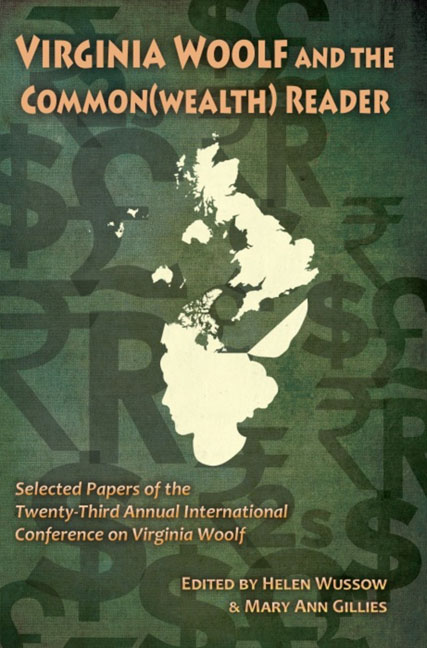Book contents
- Frontmatter
- Contents
- Introduction to Virginia Woolf and the Common(wealth) Reader
- Acknowledgments
- List of Abbreviations
- Invocations
- Networks of Affiliation: Foundations and Friends
- Woolf and the Commonwealth
- 1930s Onwards
- War, Peace, Internationalism: Bloomsbury Legacies
- “Caterpillars of the Commonwealth Unite”: Photography and Trauma in Three Guineas
- “Drawn from Our Island History”: Virginia Woolf, Nancy Mitford, and the Politics of Pageantry
- A ”Bloodless and Pernicious Pest”: The Middlebrow's “Common Man” in the Essays of Virginia Woolf
- Woolf's Troubled and Troubling Relationship to Race: The Long Reach of the White Arm of Imperialism
- Woolfian Seamarks: Commodified Women and the Racial Other on the Shores of Empire
- Documenting Fascism in Three Guineas and The Handmaid's Tale: An Examination of Woolf's Textual Notes and Scrapbooks and Atwood's “Historical Notes”
- Proportion, Conversion, Transition: War Trauma and Sites of Healing in Virginia Woolf's Mrs. Dalloway and Leslie Marmon Silko's Ceremony
- Woolf Beyond the Book
- Notes on Contributors
- Conference Program
A ”Bloodless and Pernicious Pest”: The Middlebrow's “Common Man” in the Essays of Virginia Woolf
from 1930s Onwards
- Frontmatter
- Contents
- Introduction to Virginia Woolf and the Common(wealth) Reader
- Acknowledgments
- List of Abbreviations
- Invocations
- Networks of Affiliation: Foundations and Friends
- Woolf and the Commonwealth
- 1930s Onwards
- War, Peace, Internationalism: Bloomsbury Legacies
- “Caterpillars of the Commonwealth Unite”: Photography and Trauma in Three Guineas
- “Drawn from Our Island History”: Virginia Woolf, Nancy Mitford, and the Politics of Pageantry
- A ”Bloodless and Pernicious Pest”: The Middlebrow's “Common Man” in the Essays of Virginia Woolf
- Woolf's Troubled and Troubling Relationship to Race: The Long Reach of the White Arm of Imperialism
- Woolfian Seamarks: Commodified Women and the Racial Other on the Shores of Empire
- Documenting Fascism in Three Guineas and The Handmaid's Tale: An Examination of Woolf's Textual Notes and Scrapbooks and Atwood's “Historical Notes”
- Proportion, Conversion, Transition: War Trauma and Sites of Healing in Virginia Woolf's Mrs. Dalloway and Leslie Marmon Silko's Ceremony
- Woolf Beyond the Book
- Notes on Contributors
- Conference Program
Summary
The literary marketplace of early twentieth century England has in recent years received increased critical attention, much of which has focused on the cultural hierarchies that existed within this marketplace. In particular, the middlebrow, no longer merely considered highbrow modernism's younger, duller sibling, has come under closer scrutiny as critics have begun to challenge the stability of what Andreas Huyssen calls the “great divide,” a “discourse which insists on the categorical distinction between high art and mass culture” (viii). The result is a shift in focus from evaluating the relative literary merit of art toward examining what Nicola Humble calls the “nebulousness of the divide between the highbrow and the middlebrow” (42). Humble navigates this nebulousness by suggesting that “middlebrow and highbrow books are distinguishable, fundamentally, not by any stable intrinsic differences, but by how they are read ” (46), for one sees “the gradual separation in this period of two modes of reading: the professional and the leisured” (48). Highbrow, professional readers, therefore, were reacting more against the changing uses for reading than against the content of middlebrow literature according to Humble, for as the “self-appointed guardians of the highbrow” they were concerned about the “co-option” of literature into entertainment (48). I don't necessarily disagree with Humble's argument: there were plenty of highbrow writers and thinkers—Eliot, Pound, Virginia Woolf, and the Leavises among them—who were concerned that literary taste was diminishing as, to use Q.D. Leavis's words, reading became “a form of the drug habit” (7). But to position the highbrow as the only guardians of literature in early twentieth century England downplays the fact that the middlebrow was striving just as hard to steer aesthetic taste. We can learn much from the highbrow “acts of inclusion and exclusion” and their “various models of literary culture preoccupied with…what can be ruled out in order to validate and place as securely ‘literary’ that which is ruled in” (43) suggests Humble, but what can we learn from middlebrow acts of inclusion and exclusion?
In order to answer this question, this paper focuses on a number of Virginia Woolf's essays in an attempt, firstly, to help position her within the battle of the brows and, secondly, to understand her vitriolic, yet nuanced critique of the middlebrow.
- Type
- Chapter
- Information
- Virginia Woolf and the Common(wealth) Reader , pp. 159 - 164Publisher: Liverpool University PressPrint publication year: 2014



